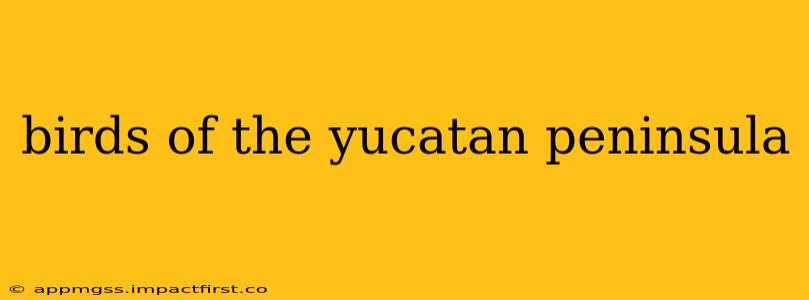The Yucatán Peninsula, a breathtaking region encompassing parts of Mexico, Belize, and Guatemala, boasts an incredible diversity of birdlife. From vibrant hummingbirds darting through lush jungles to majestic raptors soaring overhead, this peninsula offers a haven for birdwatchers and nature enthusiasts alike. This guide delves into the fascinating avian inhabitants of this unique ecosystem, exploring their habitats, behaviours, and the conservation efforts crucial to their survival.
What are some of the most common birds found in the Yucatán Peninsula?
The Yucatán Peninsula's diverse habitats—ranging from dense rainforests and coastal mangroves to scrublands and cenotes—support a wide array of bird species. Some of the most commonly sighted include:
- Resplendent Quetzal: This iconic bird, with its vibrant emerald plumage and long tail streamers, is a true highlight of the Yucatán rainforests. While not ubiquitous, encountering one remains a memorable experience.
- Brown Pelican: These large, graceful birds are frequently seen soaring along the coastline, diving for fish with impressive skill. They're a common sight near coastal towns and beaches.
- Great Blue Heron: A stately wading bird, the Great Blue Heron is often found stalking prey in shallow waters, marshes, and lagoons across the peninsula.
- White Ibis: These striking white birds with downward-curving bills are frequently observed foraging in wetlands and along shorelines.
- Various Hummingbird species: The Yucatán is a haven for hummingbirds, with numerous species exhibiting dazzling iridescent plumage and acrobatic feeding behaviors. Ruby-throated Hummingbirds and several other species are frequently seen.
- Northern Cardinal: A familiar sight in many parts of North America, the Northern Cardinal is also prevalent in the Yucatán, with its striking red plumage easily spotted amongst the greenery.
- Various Woodpeckers: Many woodpecker species inhabit the peninsula's forests, playing a vital role in maintaining the health of the ecosystem.
What is the best time of year to go birdwatching in the Yucatán Peninsula?
The best time to visit for birdwatching in the Yucatán Peninsula is during the spring and fall migration seasons (March-May and September-November). During these times, you can witness a significant increase in bird diversity as migratory species pass through or overwinter in the region. However, birdwatching is enjoyable year-round, with resident species providing ample opportunity for observation throughout the year.
What are some of the best places to go birdwatching in the Yucatán Peninsula?
The Yucatán Peninsula offers numerous fantastic birdwatching locations:
- Sian Ka'an Biosphere Reserve: A UNESCO World Heritage Site, this reserve boasts incredibly diverse ecosystems, supporting a vast array of bird species.
- Celestún Biosphere Reserve: This coastal reserve is renowned for its flamingo populations, as well as other diverse avian life.
- Calakmul Biosphere Reserve: A vast rainforest area, Calakmul offers a chance to spot numerous rainforest specialists, including the resplendent quetzal.
- Rio Lagartos: This area along the coast is known for its diverse birdlife and excellent opportunities for spotting wading birds.
- Various cenotes: The cenotes themselves don't necessarily have abundant birdlife, but the surrounding vegetation and water bodies often attract a variety of species.
What are the threats to birds in the Yucatán Peninsula?
Like many regions globally, birds in the Yucatán Peninsula face several threats:
- Habitat loss and fragmentation: Deforestation and urbanization are significant contributors to habitat loss, reducing the available space for many bird species.
- Climate change: Shifting climate patterns can alter habitats, affecting the availability of food and breeding grounds.
- Invasive species: Introduced species can compete with native birds for resources or prey on them.
- Illegal hunting and trapping: Some birds are targeted for the pet trade or for their feathers.
What conservation efforts are being undertaken to protect the birds of the Yucatán Peninsula?
Several conservation organizations and government initiatives are working to protect the region's birdlife. These efforts include:
- Establishing protected areas: Creating national parks and reserves helps safeguard critical habitats for birds.
- Sustainable land management practices: Promoting responsible forestry and agriculture reduces habitat destruction.
- Combating illegal wildlife trade: Enforcement and public awareness campaigns aim to curb illegal hunting and trafficking.
- Research and monitoring: Studying bird populations and their habitats is vital for effective conservation strategies.
By understanding the challenges facing the birds of the Yucatán Peninsula and supporting ongoing conservation efforts, we can work together to ensure the continued survival of these magnificent creatures and the preservation of this incredible avian paradise for generations to come.
